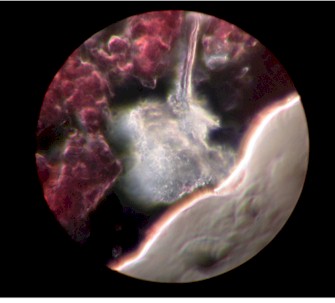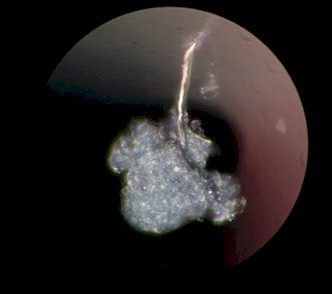

Mold Speculation
The page in which I first discussed mold was written several years ago. My own odyssey is almost at the four-year mark, and I am still battling the insurance company. In the meantime, I have had two professional mold tests performed and have implemented ever so many superficial measures. These include cleaning the ducts of the heating system, installing an ultraviolet lamp in the duct itself (right before the air is recirculated back into the house) and a extra filter in the duct system before air is heated and sent back into the house.
I have also used a negative ion generator and two different brands of portable air filters and several brands of ozone machines. To play it extra safe, I bought a Miele vacuum cleaner with HEPA filter; and periodically, I also diffuse essential oils or colloidal silver into the air, and I continue to take a lot of herbs to counteract the dangerous physical effects of mold on my health.
All of these measures are bandaids because they do not address the contamination at the core, but this is an expensive matter that the insurance company has been stonewalling.
The two mold tests involved quite different testing measures—and each "expert" tended to argue that his competitor was less competent. The first test was performed by a man who said he had developed the testing protocols for the Navy for detection of microbial agents, including mycoplasms, that might be used in the war we have to pray will never happen. He used a device that suctions ambient air onto a prepared slide with 30 squares marked. He took ten samples outdoors, ten downstairs, and ten upstairs. In addition, we sent the air filters for testing and we used some very high tech German vials for testing chemical toxins, such as formaldehyde. For the record, no formaldehyde was found. This is astonishing because the house was new, but the UV filter had been operating for several months by the time that test was performed. There was die off during the first hundred or so hours of operation of the UV system.
The second test involved tape lifts that were sent to a laboratory under chain of custody protocols. I went to the lab to see what the technician found. She used conventional brightfield microscopes and found graphium, one of the rare but dangerous molds. It's important to point out that despite all the measures I have taken, the graphium was found three years after the flood. I do not believe that my efforts to minimize risks to myself and my pets were useless, but they obviously have not been adequate.
Some weeks later, I found something curious in my own blood that was the same shape as the graphium I had seen in brightfield. For many years, I have observed that blood often moves quite quickly on the slide after removal from the fingertip. I decided to scan the opposite direction of the movement and "learned" that often the blood is fleeing something toxic. This object may be organic or inorganic, but the blood seems to try to run away from the danger. I therefore developed the habit of scanning the edges of the sample for movement lest I lose important information because an object appears outside the sample after the blood has moved away from the toxin.
Curious and cautious as I am, I sent the images that follow to the man who did the environmental testing of my house as well as the lab where his samples were analyzed. Both concurred that I had probably found graphium in my blood. Subsequently, I have sent the pictures to a number of others who are of the same opinion. I am anxious to point out that we have an educated opinion of what is shown below but we could be wrong. This said, once I observed the "mold" in my blood, my own understanding of mold was shaken to the core.
Understanding that many visitors to this site have never looked through a microscope before, I will explain a little before going on too much farther. In live blood microscopy, the sample is viable for a considerable time after being removed from the body. Only one drop of blood is required and its behavior can be observed over many hours and sometimes days.
On the first picture, it is probably safe to assume that the mold was in the middle of the blood sample before the blood fled. Therefore, what you see in the image below is an opaque area at the bottom right of the photograph that is outside the sample. On the top left, you see red blood cells that are not only crowded into each other but already turning fuzzy (dying). They are too close together because they are fleeing and "running out of space."
This photograph was taken with a Nikon Coolpix 4300 attached to a photo tube of a Motic BA300 microscope.. It is already obvious from this image that the red blood cells are moving away from the object, a form that is believed to be graphium.
Normally, I take 2-3 samples of blood at the same time. This object was only on one slide. The other slide was therefore kept for comparison purposes. The morning after the curious object was observed, I checked the slide to see what had happened.
As you can see, there was no more blood, neither red or white blood cells. There was nothing in proximity to the object and nothing left on the entire slide except the mold seen below. The control slide was perfectly normal even though the two slides were next to each on the microscope stage.
This second photograph was taken the following morning. There was nothing left on the entire slide except this object.
I have been slow sharing these images because the idea that mold might decompose the blood put me into another reality. I think I was caught between shock and curiosity. I wanted more time to research and contemplate the ramifications.
As fate would have it, I went to Austria in August to lecture and consult. Four patients who were being seen by the MD in whose office I was working also seemed to have mold in their blood. One had multiple sclerosis. Her partner had hepatitis C. The other two patients had cancer: liver cancer and ovarian cancer, both very serious. All corroborated exposure to mold; only the liver cancer patient had moved out of the contaminated house (two years previously); the other three were constantly exposed. The couple had plans to move on October 1st and hopefully will start to get better. It is worth noting that compared to these patients, I seemed relatively well and functional; however, none of the patients had the symptoms of allergies that I had; and they were therefore less aware of the hazards of their environments.
Still not satisfied, I continued to research and discuss the situation with colleagues. The University of Adelaide (Australia) web site has a fabulous gallery of mold pictures, including many of cancer patients whose tumors were found to be mold colonies. For those who might be jumping ahead, keep in mind that tumors are sometimes not exactly what they are described as being. For instance, some tumors seem to consist of parasites (see the CDC web site for another visual tour of health horrors.)
Since this was my first insight into what mold might actually be doing in the body, I have been exceptionally careful with the information. Before seeing this with my own eyes, I assumed that mold was ingesting, digesting, and excreting toxic by-products that damage organs. I believed that the chief danger to people who are infected with mold was allergic reactions and possibly organ damage from toxic gases and metabolites. However, after studying this picture, I came to suspect that the manner in which mold acts to decompose is vastly more efficient than anyone has estimated.
Last week, an old friend who happens to be a surgeon came by to see me. He was interested in my microscope so he pricked his finger and lo and behold: mold! He said he had been renovating a hundred year-old building and had been exposed to lots of mold. However, it was obviously a different species because the mechanism of its action was different. Nevertheless, his blood was not in good condition.
The Learning Curve
As with all new pursuits, there is a lot to learn. With cancer, I have often warned patients who are passionate about information that they are racing the clock so wisdom usually dictates the need to confer with people who are further along on the learning curve. With mold, such options are not readily available. I discovered this when my lawyer wanted me to see an out-of-state medical doctor who would run a battery of tests to prove mold caused damage to my central nervous system. I asked other lawyers about her recommendation. The first said that the defense attorney would get someone from the University of Washington to say that they knew of no long-term medical risks from mold exposure. So much for "expert" witnesses!
Another attorney told me that the jury would not understand the arguments so the risk of losing was great. A friend who is a doctor told me that no jury would believe I had lost brain power. I think he meant to be funny and friendly, but I decided to waive damages related to health because of intimidation. My own lawyer told me that the defense attorneys could force me to have lumbar punctures. I also believe firmly that it is more important to protect oneself than to be paid for suffering. Thus, I continued to explore herbs, but to know what might work in which circumstances, I had to know what the various molds might actually be doing inside the body. Obviously, they are doing what molds do: decomposing.
Herbs
The first herb that was presented to me as suitable for use with mold was jatobá, Hymenaea courbaril, a Brazilian herb. A Chilean lady who used to own a small chain of health foods stores gave me a bottle. It was love at first sight. Everything about jatobá is fascinating. It produces a resin that exudes the most exotic pheromonal enticers I have ever sniffed. The tree is tall and is pollinated by bats. The resin converts to amber in the short geological span of a million years, but more importantly, jatobá is a superb supporter of the adrenals, something much needed by people who are allergic, anemic, and tired from mold exposure and blood loss.
As Leslie Taylor, owner of Rain Tree Nutrition, explained to me, to survive in the rain forest, a tree must be able to defend itself against termites and mold. Rain forest trees therefore exude odors that repel or they have toxins in their bark that protect them against the threats which are sometimes not miniature but microscopic!

Jatobá has a complex chemical structure and contains chemicals that are known to be not only antifungal but also antitumoral, anti-inflammatory, and antibacterial. Clinical studies suggest it is also helpful in the battle against Candida albicans and high blood sugar.
I have been using jatobá for nearly five years now.
God bless!
Copyright by Ingrid Naiman 2001, 2006, and 2014
Images from my own blood and the protocols I am using for myself
See also Mold Misery, a new site!

Sacred Medicine Sanctuary
Copyright by Ingrid Naiman 2001, 2006, and 2014
The information on this site is presented as a public service. The site owner, author(s), Seventh Ray Press, Sacred Medicine Sanctuary, server, and web manager(s) are not responsible for how the information is applied nor for any outcomes.
The information provided on this site is for educational and informational purposes only. The statements and products have not been evaluated by the Food and Drug Administration and are not intended to diagnose, treat, cure, or prevent any disease.
The material on this site should not be used to replace professional medical care. You should always consult a health professional about specific health concerns and problems.



